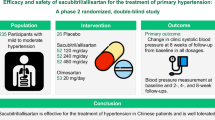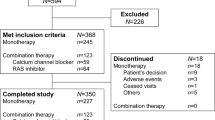Abstract
A prespecified subgroup analysis of an open-label, multicenter, single-arm, dose-titration study is presented. The efficacy and safety of 20-week treatment with an amlodipine (AML)/olmesartan medoxomil (OM)±hydrochlorothiazide (HCTZ) algorithm were assessed in patients with hypertension and type 2 diabetes mellitus (T2DM) who were uncontrolled by antihypertensive monotherapy. Eligible patients received AML/OM 5/20 mg for 4 weeks, followed by stepwise uptitration to AML/OM 5/40 mg, AML/OM 10/40 mg, AML/OM 10/40 mg+HCTZ 12.5 mg and AML/OM 10/40 mg+HCTZ 25 mg at 4-week intervals if blood pressure (BP) remained uncontrolled. The primary end point was the achievement of the seated cuff systolic BP (SeSBP) goal (<140 mm Hg, or <130 mm Hg for patients with T2DM) at week 12. Seated cuff BP was significantly reduced from baseline at all titration dose periods. At week 12, the cumulative SeSBP goal was achieved by 57.9% and 80.1% of patients in the T2DM and non-T2DM subgroups, respectively. Treatment was well tolerated, with low rates of peripheral edema. In summary, switching to a treatment algorithm based on AML/OM±HCTZ after failed monotherapy was safe and improved BP control in patients with hypertension and T2DM.
This is a preview of subscription content, access via your institution
Access options
Subscribe to this journal
Receive 12 digital issues and online access to articles
$119.00 per year
only $9.92 per issue
Buy this article
- Purchase on Springer Link
- Instant access to full article PDF
Prices may be subject to local taxes which are calculated during checkout







Similar content being viewed by others
References
Grundy SM, Cleeman JI, Daniels SR, Donato KA, Eckel RH, Franklin BA et al. Diagnosis and management of the metabolic syndrome: an American Heart Association/National Heart, Lung, and Blood Institute Scientific Statement. Circulation 2005; 112 (17): 2735–2752.
Lloyd-Jones D, Adams RJ, Brown TM, Carnethon M, Dai S, De Simone G et al. Heart disease and stroke statistics–2010 update: a report from the American Heart Association. Circulation 2010; 121 (7): e46–e215.
Yoon SS, Ostchega Y, Louis T . Recent trends in the prevalence of high blood pressure and its treatment and control, 1999-2008. NCHS Data Brief, 48, Hyattsville, MD: National Center for Health Statistics, 2010.
Egan BM, Zhao Y, Axon RN . US trends in prevalence, awareness, treatment, and control of hypertension, 1988-2008. JAMA 2010; 303 (20): 2043–2050.
Wong ND, Lopez VA, L'Italien G, Chen R, Kline SE, Franklin SS . Inadequate control of hypertension in US adults with cardiovascular disease comorbidities in 2003–2004. Arch Intern Med 2007; 167 (22): 2431–2436.
Haffner SM, Lehto S, Ronnemaa T, Pyorala K, Laakso M . Mortality from coronary heart disease in subjects with type 2 diabetes and in nondiabetic subjects with and without prior myocardial infarction. N Engl J Med 1998; 339 (4): 229–234.
Schmieder RE, Ruilope LM . Blood pressure control in patients with comorbidities. J Clin Hypertens (Greenwich) 2008; 10 (8): 624–631.
American Diabetes Association. Standards of medical care in diabetes–2011. Diabetes Care 2011; 34 (Suppl 1): S11–S61.
American Diabetes Association. Standards of medical care in diabetes–2012. Diabetes Care 2012; 35 (Suppl 1): S11–S63.
Chrysant SG, Melino M, Karki S, Lee J, Heyrman R . The combination of olmesartan medoxomil and amlodipine besylate in controlling high blood pressure: COACH, a randomized, double-blind, placebo-controlled, 8-week factorial efficacy and safety study. Clin Ther 2008; 30 (4): 587–604.
Epstein BJ, Vogel K, Palmer BF . Dihydropyridine calcium channel antagonists in the management of hypertension. Drugs 2007; 67 (9): 1309–1327.
Law MR, Wald NJ, Morris JK, Jordan RE . Value of low dose combination treatment with blood pressure lowering drugs: analysis of 354 randomised trials. BMJ 2003; 326 (7404): 1427.
Bakris GL . Combined therapy with a calcium channel blocker and an angiotensin II type 1 receptor blocker. J Clin Hypertens (Greenwich) 2008; 10 (1 Suppl 1): 27–32.
Dahlof B, Sever PS, Poulter NR, Wedel H, Beevers DG, Caulfield M et al. Prevention of cardiovascular events with an antihypertensive regimen of amlodipine adding perindopril as required versus atenolol adding bendroflumethiazide as required, in the Anglo-Scandinavian Cardiac Outcomes Trial-Blood Pressure Lowering Arm (ASCOT-BPLA): a multicentre randomised controlled trial. Lancet 2005; 366 (9489): 895–906.
Jamerson K, Weber MA, Bakris GL, Dahlof B, Pitt B, Shi V et al. Benazepril plus amlodipine or hydrochlorothiazide for hypertension in high-risk patients. N Engl J Med 2008; 359 (23): 2417–2428.
Mancia G, Laurent S, Agabiti-Rosei E, Ambrosioni E, Burnier M, Caulfield MJ et al. Reappraisal of European guidelines on hypertension management: a European Society of Hypertension Task Force document. Blood Press 2009; 18 (6): 308–347.
Fabia MJ, Abdilla N, Oltra R, Fernandez C, Redon J . Antihypertensive activity of angiotensin II AT1 receptor antagonists: a systematic review of studies with 24 h ambulatory blood pressure monitoring. J Hypertens 2007; 25 (7): 1327–1336.
Weir MR, Hsueh WA, Nesbitt SD, Littlejohn TJ, Graff A, Shojaee A et al. A titrate-to-goal study of switching patients uncontrolled on antihypertensive monotherapy to fixed-dose combinations of amlodipine and olmesartan medoxomil ± hydrochlorothiazide. J Clin Hypertens 2011; 13 (6): 404–412.
Chobanian AV, Bakris GL, Black HR, Cushman WC, Green LA, Izzo JL et al. Seventh report of the Joint National Committee on Prevention, Detection, Evaluation, and Treatment of High Blood Pressure. Hypertension 2003; 42 (6): 1206–1252.
McNeill AM, Rosamond WD, Girman CJ, Golden SH, Schmidt MI, East HE et al. The metabolic syndrome and 11-year risk of incident cardiovascular disease in the atherosclerosis risk in communities study. Diabetes Care 2005; 28 (2): 385–390.
Flack JM, Sica DA, Bakris G, Brown AL, Ferdinand KC, Grimm RH et al. Management of high blood pressure in Blacks: an update of the International Society on Hypertension in Blacks consensus statement. Hypertension 2010; 56 (5): 780–800.
Mancia G, De Backer G, Dominiczak A, Cifkova R, Fagard R, Germano G et al. 2007 ESH-ESC practice guidelines for the management of arterial hypertension: ESH-ESC task force on the management of arterial hypertension. J Hypertens 2007; 25 (9): 1751–1762.
Barrios V, Brommer P, Haag U, Calderon A, Escobar C . Olmesartan medoxomil plus amlodipine increases efficacy in patients with moderate-to-severe hypertension after monotherapy: a randomized, double-blind, parallel-group, multicentre study. Clin Drug Investig 2009; 29 (7): 427–439.
Volpe M, Brommer P, Haag U, Miele C . Efficacy and tolerability of olmesartan medoxomil combined with amlodipine in patients with moderate to severe hypertension after amlodipine monotherapy: a randomized, double-blind, parallel-group, multicentre study. Clin Drug Investig 2009; 29 (1): 11–25.
Chavanu K, Merkel J, Quan AM . Role of ambulatory blood pressure monitoring in the management of hypertension. Am J Health Syst Pharm 2008; 65 (3): 209–218.
Parati G, Mancia G . Ambulatory blood pressure monitoring in clinical practice. J Hypertens 2002; 20 (10): 1925–1927.
Muller JE, Tofler GH, Stone PH . Circadian variation and triggers of onset of acute cardiovascular disease. Circulation 1989; 79 (4): 733–743.
Neutel JM . The importance of 24-h blood pressure control. Blood Press Monit 2001; 6 (1): 9–16.
Chrysant SG, Oparil S, Melino M, Karki S, Lee J, Heyrman R . Efficacy and safety of long-term treatment with the combination of amlodipine besylate and olmesartan medoxomil in patients with hypertension. J Clin Hypertens (Greenwich) 2009; 11 (9): 475–482.
Chrysant SG . Proactive compared with passive adverse event recognition: calcium channel blocker-associated edema. J Clin Hypertens (Greenwich) 2008; 10 (9): 716–722.
Volpe M, Miele C, Haag U . Efficacy and safety of a stepped-care regimen using olmesartan medoxomil, amlodipine and hydrochlorothiazide in patients with moderate-to-severe hypertension: an open-label, long-term study. Clin Drug Investig 2009; 29 (6): 381–391.
Acknowledgements
This study was supported by Daiichi Sankyo, Inc. Medical writing and editorial services were provided by Robert Schupp, PharmD, Latoya M Mitchell, PhD, and Alan J Klopp, PhD, of inScience Communications, Springer Healthcare.
Author information
Authors and Affiliations
Corresponding author
Ethics declarations
Competing interests
Shawna D Nesbitt is on the speakers’ bureau for Novartis, Boehringer Ingelheim and Forest Laboratories and serves on an advisory board for Daiichi Sankyo, Inc. Ali Shojaee and Jen-Fue Maa are employees of Daiichi Sankyo, Inc. Matthew R Weir is an ad-hoc scientific consultant for Daiichi Sankyo, Inc., Novartis, Amgen and NicOx.
Additional information
Supplementary Information accompanies the paper on the Journal of Human Hypertension website
Rights and permissions
About this article
Cite this article
Nesbitt, S., Shojaee, A., Maa, JF. et al. Efficacy of an amlodipine/olmesartan treatment algorithm in patients with or without type 2 diabetes and hypertension (a secondary analysis of the BP-CRUSH study). J Hum Hypertens 27, 445–452 (2013). https://doi.org/10.1038/jhh.2012.65
Received:
Revised:
Accepted:
Published:
Issue Date:
DOI: https://doi.org/10.1038/jhh.2012.65
Keywords
This article is cited by
-
Educational Interventions May Promote Better Blood Pressure Control in Russia
High Blood Pressure & Cardiovascular Prevention (2017)
-
Olmesartan medoxomil: a guide to its use as monotherapy or in fixed-dose combinations with amlodipine and/or hydrochlorothiazide
Drugs & Therapy Perspectives (2016)
-
Assessment of the Cardiovascular Risk of Olmesartan Medoxomil-Based Treatment: Meta-Analysis of Individual Patient Data
American Journal of Cardiovascular Drugs (2016)
-
Efficacy and safety of olmesartan medoxomil/amlodipine fixed-dose combination for hypertensive patients uncontrolled with monotherapy
Archives of Pharmacal Research (2014)
-
RETRACTED ARTICLE: Different Aspects of Sartan + Calcium Antagonist Association Compared to the Single Therapy on Inflammation and Metabolic Parameters in Hypertensive Patients
Inflammation (2014)



